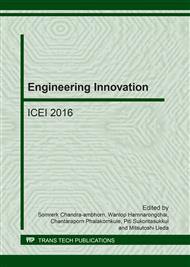[1]
L. Courard, Parametric study for the creation of the interface between concrete and repair products. Mater. Struct. 33 (2000) 65-72.
DOI: 10.1007/bf02481698
Google Scholar
[2]
Ł. Sadowski, T. G. Mathia, Multi-scale metrology of concrete surface morphology: Fundamentals and specificity, Construct. Build. Mater. 113 (2016) 613-621.
DOI: 10.1016/j.conbuildmat.2016.03.099
Google Scholar
[3]
J. Hoła, J. Bień, Ł. Sadowski, K. Schabowicz, Non-destructive and semi-destructive diagnostics of concrete structures in assessment of their durability, Bulletin of the Polish Academy of Science Technic. Sci. 63 (2015) 87-96.
DOI: 10.1515/bpasts-2015-0010
Google Scholar
[4]
PN-EN 1504-10: Products and systems for the protection and repair of concrete structures. Definitions. Requirements. Quality control and evaluation of conformity. Site application of products and systems and quality control of the works, PKN, Warszawa (2005).
DOI: 10.3403/30327978
Google Scholar
[5]
A. Garbacz, M. Krystosiak, Ultrasonic evaluation of adhesion between polymer coating and concrete substrate, 31 Krajowa Konferencja Badań nieniszczących – KKBN Szczyrk (2002).
Google Scholar
[6]
Ł. Sadowski, J. Hoła, New nondestructive way of identifying the values of pull-off adhesion between concrete layers in floors, J. Civ. Eng. Manage. 20 (2014) 561-569.
DOI: 10.3846/13923730.2014.897642
Google Scholar
[7]
K. Grigoriadis, Use of laser interferometry for measuring concrete substrate roughness in patch repairs, Automat. Construct. 64 (2016) 27-35.
DOI: 10.1016/j.autcon.2015.12.025
Google Scholar
[8]
S. Czarnecki, Non-destructive evaluation of the bond between a concrete added repair layer with variable thickness and a substrate layer using ANN, Procedia Engineering (2016) (accepted).
DOI: 10.1016/j.proeng.2017.02.049
Google Scholar
[9]
Ł. Sadowski, Non-destructive identification of pull-off adhesion between concrete layers, Automat. Construct. 57 (2015) 146-155.
DOI: 10.1016/j.autcon.2015.06.004
Google Scholar
[10]
J. Szymanowski, Ł. Sadowski, Adhesion assessment between concrete layers using the ultrasonic pulse velocity method. App. Mechan. Mater. 797 (2015) 145-150.
DOI: 10.4028/www.scientific.net/amm.797.145
Google Scholar
[11]
Information on http: /www. sto. pl/129718_PL-StoPox_BB_OS_PL. pdf.
Google Scholar
[12]
Ł. Sadowski, S. Czarnecki, J. Hoła. Evaluation of the height 3D roughness parameters of concrete substrate and the adhesion to epoxy resin, Inter. J. Adhesion Adhesives 67 (2016) 3-13.
DOI: 10.1016/j.ijadhadh.2015.12.019
Google Scholar
[13]
PN-EN 12504-3: Testing concrete in structures. Determination of pull-out force, PKN, Warsaw (2006).
Google Scholar
[14]
PN-EN 12504-4: Testing concrete. Determination of ultrasonic pulse velocity, PKN, Warsaw (2005).
Google Scholar
[15]
Ł. Drobiec, R. Jasiński, A. Piekarczyk, Reinforced concrete construction diagnostics, Vol. 1: Metodology, field research, laboratory test of concrete and steel, Scientific Company PWN, Warsaw (2010) (in Polish).
Google Scholar


